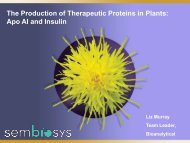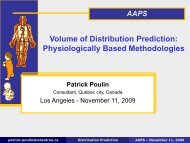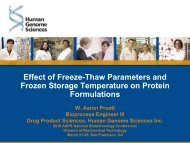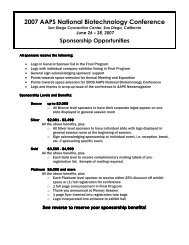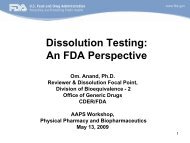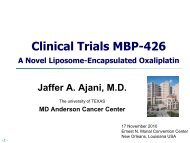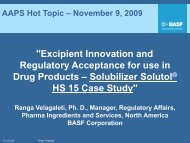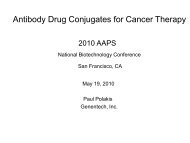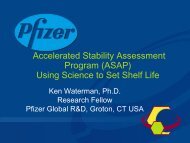(MS)?
(MS)?
(MS)?
You also want an ePaper? Increase the reach of your titles
YUMPU automatically turns print PDFs into web optimized ePapers that Google loves.
From Small-Molecule Drugs to Proteomics –Mass Spectrometry and its Evolutionto a Universal ToolMichael Karas, Inst. for Pharmaceutical ChemistryGoethe-University of Frankfurt, Germany
MASS SPECTROMETRYMASS SPECTRUMIntensityRelativ : %Absolut :• mV• countsfragment-ionpeaksbase peakisotopicpeaksmolecular-ionpeakm/z = mass number / charge number
Relative AbundanceTandem<strong>MS</strong>or<strong>MS</strong>/<strong>MS</strong>M I C H A E L K A R A S100806040200MICH A E L K A R A SB11B4485.0B101224.4Y’’61295.41153.4B7B8645.3 B6B5B9798.2 Y’’101196.4Y’’8979.31111.3685.1 926.2 997.3 1085.4556.1 845.4400 500 600 700 800 900 1000 1100 1200 1300 14001312.31329.3m/z
Why mass spectrometry (<strong>MS</strong>)?SpecificityUncoded InformationSpeed Sensitivity Versatility• Identification of chemical compounds via theirfundamental property, the mass specific exact mass + characterist. fragment ions sensitive sample amount in pmol range or < fast analysis takes sec. to a few minutes Versatile applicable to nearly all classes of compounds
5000400030002000conferenceuntil 2004 1990 continous but slow growth•• • ••6-6500 att.Major limitations: Ionization techniques only forsmall, thermally stabile compounds= widespread use of GC-<strong>MS</strong> no robust and universal couplingbetween HPLC and <strong>MS</strong>1000•1950 1960 1970 1980 1990 2000
500040003000•• • ••20046-7000 att.starting at 1984/85....breakthrough bytwo newionization techniques :20001000•ESI(Electrospray-Ionization)&MALDI(Matrix-Assisted LaserDesorption Ionization)1950 1960 1970 1980 1990 2000
MALDI- Matrix AssistedLaser Desorption IonizationIncorporation of sample molecules into the matrixirradiation with short-pulse UV-Laser in high vacuumMatrices : small organic compounds with high absorption coeff.at laser-N 2 -Laser : = 337 nm, = 3 nsFokus- 200 µm
MALDI sample preparation"Dried droplet"analyte:protein/peptidematrix:DHBsolve10 -5 -10 -7 Min H 2 O/ACN0.1% TFA5-50 g/LinH 2 O/ACN0.1% TFAdripsolutionslet dry<strong>MS</strong>
nevertheless a difficult start
the mass spectrometer starts with ahole in the vacuum chamber
can an exact protein molecular mass be sufficient tocharacterize a protein ?!MALDI-<strong>MS</strong> of proteins:Monoclonal IgG: ~150 000 DaMH +40000300002000010000(2M+H) +(M+2H) 2+(3M+H) +(M+3H) 3+300000 400000 500000 600000050000 100000 150000 200000 250000 300000 350000
Native mass spectrometryESI many successful examples> 1 MDa
% Intensity% IntensityNative MALDI mass spec for siRNANative10090807060StandardSS 2DS12071.0 12211.8 12352.6 12493.4 12634.21.3E+4MALDI-<strong>MS</strong> and<strong>MS</strong>/<strong>MS</strong> for smallRNA delivers :50403020106263.86129.66020 6086 6152 6218 6284 635012380.803600 5580 7560 9540 11520 13500Mass (m/z)• stability of RNAdouble strands• excess of singlestrands1009080706050StandardDenatured1.2E+4when combinedto acid hydrolysis• RNA sequence(also for modified)40302010unspecific dimers03600 5580 7560 9540 11520 13500Mass (m/z)
ESI and today also MALDI solved an old analytical problem routine, sensitive and robust coupling of HPLC to <strong>MS</strong>fused silica capillaryID 50-75 µm
ESI and today also MALDI solved an old analytical problem routine, sensitive and robust coupling of HPLC to <strong>MS</strong>
ESI and today also MALDI solved an old analytical problem routine, sensitive and robust coupling of HPLC to <strong>MS</strong> accompanied by a dramatic advancement of <strong>MS</strong> instruments which also strongly improves small-molecule analyses
Small-molecule MALDIQuantification of acetylcholine und choline in brain dialysate(Coop. Inst. of Pharmacology, Univ. of Frankfurt)N +OON +OH• HPLC not needed• directly from physiological salt conc.• standard dried-droplet preparation• making use of the higher rep rate of the 4800MALDI-TOF(TOF)• accumulation of 2000 laser shots• lower required sample amounts(0.5 µL) allowed us to measuretime-resolved
Results 50 fmol/µL ACh_ 48005 pmol/µL Ch% Intensity10080212.0367146.0593846.8146.1172Acetylcholin: 146.11768.9E+4[Matrix-CO 2 +H] + : 146.060060234.0198Choline40IS2IS1104.1070178.1338228.0123249.99722038.9637113.1627172.0395190.050023.0683 160.1338265.9758379.1466010.0 88.4 166.8 245.2 323.6 402.0Mass (m/z)25
Analyte/IS*ConcAnalyte/IS*Conc10.90.80.70.60.50.40.30.20.10Conc. Ch [pmol/µL]0 10 20 30 40 50 600 0.2 0.4 0.6 0.8 1 Conc. [pmol/µL] 1.2Conc. ACh [pmol/µL]0 1 2 3 4 5 60.050.0450.040.0350.03R² = 0.9996R² = 0.9995Acetylc…Cholin80706050403020100R² = 0.9981121080.0250.020.0150.010.0050R² = 0.9996Acetylcholine0 10 20 30 40 50 60Conc. [fmol/µL]6420
from protein biochemistry to proteomics :mass spectrometry as a central toolfor a new start in biological sciencesorfrom peptides to proteins and back to peptides
in order to analyze a proteome key technologies areneeded‣ methods to identify proteins from extremely complexmixtures without bias, comprehensively and in highthroughput‣ methods to quantify differences in protein expression‣ methods to characterize protein modifications‣ bioinformatic tools for data analysis and storageEstablishment ofDiscoveryProteomics :<strong>MS</strong> +Chromatographie +Proteinbiochemistry +Bioinformatics‣ further questions :localizationinteraction with proteins and small moleculesdynamicslife time
general strategiesin proteomicspossibly viable inthe futurecurrentlyunderdelelopment???proteinidentifcation bypeptide massfingerprint
1-the conventional way :"MALDI peptidemass fingerprint"
general strategiesin proteomicspossibly viable inthe futurecurrentlyunderdelelopment???
Protein Identifizierung : ESI or MALDI)-<strong>MS</strong>/<strong>MS</strong>Analyse von Peptidfragmenten2-"gel-free" =HPLC-<strong>MS</strong>/<strong>MS</strong>manynanoHPLC (often 2D needed =combined to SCX or IEF)proteinsextremely high numberof peptides
+ low protein amount in complex mixture feasible for characterization of biologicals
in order to analyze a proteome key technologies are needed‣ methods to identify proteins from extremely complexmixtures without bias, comprehensively and in highthroughput‣ methods to quantify differences in protein expression‣ methods to characterize protein modifications‣ bioinformatic tools for data analysis and storage‣ further questions :localizationinteraction with proteins and small moleculesdynamicslife time
in order to analyze a proteome key technologies are needed‣ methods to identify proteins from extremely complexmixtures without bias, comprehensively and in highthroughput‣ methods to quantify differences in protein expression‣ methods to characterize protein modifications‣ bioinformatic tools for data analysis and storage‣ further questions :localizationinteraction with proteins and small moleculesdynamicslife time
Remaining problems :• possibly low concentration of modified peptides• chemically labile modifications new fragmentation tools for <strong>MS</strong>/<strong>MS</strong> combine chemistry and <strong>MS</strong>/<strong>MS</strong>
peptide identificationBioinformaticsstable isotope quantific.Proteomics?discovery high-throughputapproach finally deliveringon its promisehypothesis driven approachtrQ-MRM
(self)critical discussion about proteomics strategiesNATURE|VOL 429 | 3 JUNE 2004
the actual Proteomics debatediscovery high-throughputapproach finally deliveringon its promise"Proteomics has progressed radically in the last 5 years and is now on par with most genomictechnologies in throughput and comprehensiveness. Analyzing peptide mixtures by liquidchromatography coupled to high-resolution mass spectrometry (LC-<strong>MS</strong>) has emerged as the maintechnology for in-depth proteome analysis .... <strong>MS</strong>-based proteomics is rapidly becoming quantitativethrough both label-free and stable isotope labeling technologies. The latest generation of massspectrometers combines extremely high resolving power,mass accuracy, and very high sequencingspeed in routine proteomic applications...Thus, in a few specialized laboratories, ‘‘precision proteomics’’ can nowidentify and quantify almost all fragmented peptide peaks.
ut with large efforts and investments...
...the other side of the medal detection ofbiomarkers from plasma
the alternative.....back to hypothesis-driven researchabandon"discovery-driven""shotgun"approach
in advanced TripleQ instruments• a list a putatively interesting proteins is generated based onactual biological knowledge (multiplexing) or hypothesis• proteotypic peptides are selected from experience or predicted,their <strong>MS</strong>/<strong>MS</strong> spectra are known and a few <strong>MS</strong>/<strong>MS</strong>transitions selected• the <strong>MS</strong> system carries out targeted <strong>MS</strong>/<strong>MS</strong> analyses of onlythese few specific <strong>MS</strong>/<strong>MS</strong> transitions( highest possible sensitivity)
A new tool MALDI imaging mass spectrometry„Imaging mass spectrometry: A new technology for the analysis of protein expression in mammaliantissues“ M. Stoeckli, P. Chaurand, D. E. Hallahan & R. M. Caprioli, Nature Medicine 7 (2001) 493-496.
A new tool MALDI imaging mass spectrometrydistribution of olanzapinedetection by SRM
AK KarasU. Bahr, Ph.DB. Meyer, Ph.DM. Persike, PhDA. ArnoldT. ArreyD. BäumlisbergerT. BeckhausV. JüngstJ. GorkaT. JaskollaS. MarkoutsaB. MüllerD. PapasitiriouM. RohmerT. SchorgeM. SchürkenD. UrbanekThanks for yourattentionThanks for yourFrankfurt, Mainattention



